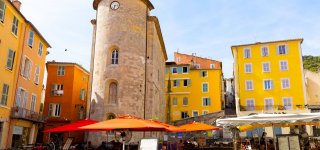The city of Hyeres
Territory occupied by humans since prehistoric times, Hyères then housed in antiquity, in the 4th century BC, the Greek fortified trading post of Olbia. Nearby, the Romans founded two centuries later the galleys Pomponiana station. Olbia is definitively abandoned under the Merovingian dynasty in the 6th century AD. First lord of Hyères, Fos Pons built a castle in the early 11th century, after the expulsion of the Saracens. He also erected the St. Nicolas church. A town developed around the baronial castle, there are still remains today. In the 14th century, the city extends down the hill and new walls are high to integrate the suburbs. The tour of the upper town still allows to see the doors Massillon and Fenouillet in these fortifications seconds. The 15th century was marked by the construction of the Jean-Mat channel also called béal Hyères. In the 16th century, the destination attracts for its setting and its climate: Catherine de Medici and Charles IX staying in 1564. The palms of Hyères, already mentioned in the Renaissance, centuries later will the reputation of the city. In the 19th century, the palms of horticulturists of Hyères are exported internationally. The city attracts the aristocracy for its mild winters. Magnificent villas and large mansions are built.
In the 20th century, in the Roaring Twenties, the Villa Noailles modern architecture is the preferred rendezvous of all the artistic avant-garde: it receives Man Ray, Cocteau, Picasso and Dali. Today center of art and architecture, it remains a unique place in France whose programming has thematic architecture, design, fashion and photography.
Labeled "City of Art and History", Hyères has a rich architectural and cultural heritage, to discover during business dedicated circuits such as art, the medieval past or Hyères 19th century. Notable sites include Hyeres ramparts and ruins of the castle of the Knights Templar tower, castle St. Clair, Peñiscola, the old wash and remarkable mansions like the Tunisian villa Moorish villa, the Roman villa or St. Hubert villa. Several religious buildings part of the charm of the city: St. Paul's collegiate church, the Anglican Church and the Church of St. Louis for the center of Hyères.
renowned destination for its gardens, Hyeres has several parks and green spaces labeled "remarkable gardens". The garden Olbius Riquier is ideal for families. In particular it has a little train, games, a small zoo, a carousel and a tavern. Little paradise overlooking the medieval town and opening on the Mediterranean and the Golden Islands, the St. Clair castle park is famous for its rare species of plants brought from Australia and South America. At the foot of the Villa Noailles, the Saint Bernard park down the hillside terraces. The Mediterranean species there exhale their enchanting scents.
Territory unique natural heritage, Hyères includes the Giens peninsula that houses the salt, and the archipelago of three islands formed by Golden Porquerolles, Port-Cros and Ile du Levant. Protected Natural Area for its exceptional biodiversity, the National Park of Port Cros is the first marine park in Europe. The Giens peninsula is home for its bird sanctuary: many migratory species carry an annual stop on the pond Pesquiers. The Golden Isles conceal heavenly beaches and unexpected natural resources. Their access is by boat and motor vehicles are prohibited. The waters of Hyères are finally included within the Pelagos Sanctuary, a protected area where you can meet dolphins, sea turtles, whales or whale. Boat cruises to meet them are available from the port.
